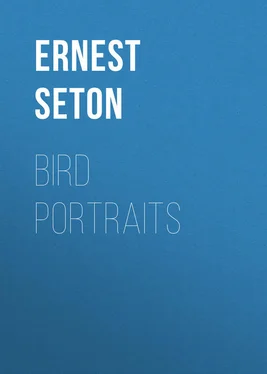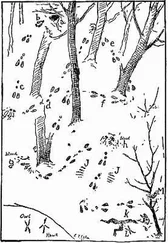Ernest Seton - Bird Portraits
Здесь есть возможность читать онлайн «Ernest Seton - Bird Portraits» — ознакомительный отрывок электронной книги совершенно бесплатно, а после прочтения отрывка купить полную версию. В некоторых случаях можно слушать аудио, скачать через торрент в формате fb2 и присутствует краткое содержание. Жанр: foreign_prose, на английском языке. Описание произведения, (предисловие) а так же отзывы посетителей доступны на портале библиотеки ЛибКат.
- Название:Bird Portraits
- Автор:
- Жанр:
- Год:неизвестен
- ISBN:нет данных
- Рейтинг книги:4 / 5. Голосов: 1
-
Избранное:Добавить в избранное
- Отзывы:
-
Ваша оценка:
- 80
- 1
- 2
- 3
- 4
- 5
Bird Portraits: краткое содержание, описание и аннотация
Предлагаем к чтению аннотацию, описание, краткое содержание или предисловие (зависит от того, что написал сам автор книги «Bird Portraits»). Если вы не нашли необходимую информацию о книге — напишите в комментариях, мы постараемся отыскать её.
Bird Portraits — читать онлайн ознакомительный отрывок
Ниже представлен текст книги, разбитый по страницам. Система сохранения места последней прочитанной страницы, позволяет с удобством читать онлайн бесплатно книгу «Bird Portraits», без необходимости каждый раз заново искать на чём Вы остановились. Поставьте закладку, и сможете в любой момент перейти на страницу, на которой закончили чтение.
Интервал:
Закладка:
Ernest Seton-Thompson
Bird Portraits
INTRODUCTION
This book is called "Bird Portraits" because Mr. Seton-Thompson's pictures are always faithful and charming portraits of the birds which he draws. But since a bird's portrait, no matter how accurate, can show its subject in only one position, singing, feeding, flying, or sitting, a short account of some of the main events of the bird's life has been added to each picture.
Any one who learns from such books as Mr. Seton-Thompson's how beset with perils is the life of every wild creature will take the greatest pains at all times, and especially in the nesting season, not only not to injure or persecute such defenseless little creatures as our song birds, but also to protect them in every way. Whoever seeks their acquaintance, in the spirit of friendship, will always be grateful for the interest and pleasure to be gained from such friends.
Of the twenty birds whose portraits are here presented, a majority are only summer residents in the Northern States; some visit us only in winter; a few spend the whole year near the same spot. The birds which are first described are those that are most closely associated with the return of spring; then follow those whose gay colors and bright songs give much of its charm to early summer; last come those that brave, even in the North, the tempests of winter.
R. H.THE SONG SPARROW
After a severe winter, while snow and ice still remind us of the past, the Song Sparrow, mounting to the top of some bush or small tree, repeats his cheerful tinkling song, "helping," as Thoreau says, "to crack the ice" in the ponds. Few people are so unobservant as not to notice this bright strain, after the silence of winter. A peculiarity of the song is the amount of variation shown by different individuals and often by the same bird. At almost regular distances along the bushy roadside, or over the hedge-intersected fields, one will meet on the early spring mornings one Song Sparrow after another, each restricted to his part of the road or field. If one notices the songs of each, it is evident that, though the songs have the same general character, there are almost as many ways of beginning a strain as there are singers. Moreover, the same bird has been observed to alter his song in a short space of time to two or three different variations. Probably, if one's ear were acute enough, all birds of one species would be found to sing with slight differences, but few show in so marked a degree as the Song Sparrow the tendency to variation which characterizes a species.
In early April, the Song Sparrow builds a nest of grass, either on the ground beneath a tuft of grass, or under some brambles, or less frequently a few feet above the ground, in a bush or on the lower limbs of a tree. In the latter situation, twigs are of course necessary for the support of the structure. Here again the bird shows a tendency to vary in its habits. The eggs are from four to five in number, greenish white, thickly marked with shades of brown, lavender, or purple. Sometimes an egg is found in the nest much larger than the others; this has been laid by the lazy Cowbird. As the large egg receives most warmth and hatches first, the young Cowbird soon crowds out the rightful occupants of the nest, and the parent Song Sparrows will be seen later, working busily to feed a great homely youngster as large as themselves, who will afterwards go off to join a flock of his own kind. Probably every Cowbird has been reared at the expense of a brood of some small bird, Sparrow, Warbler, or Vireo.
In June, the young Song Sparrows are able to take care of themselves, and the energetic parents build another nest and rear another brood. The brooding time is the chief period of song, so that birds that breed twice sing later in the summer than others. The Song Sparrow's little strain may be heard well into August; but toward the end of that month we hear from the cornfields and gardens a curious, husky warble, unlike the bright spring carol of the Song Sparrow, but nevertheless made by that bird. In the fall, and even during the winter, a warm bright day will occasionally induce a Song Sparrow to sing his lively spring song, so that where the Song Sparrow winters, the strain may be heard every month of the year.
In the late summer and fall, the neglected corners of gardens and fields, where the seeds of weeds and grasses offer an abundance of food, are the favorite resort of the sparrows. The Song Sparrow may be distinguished from most of its relatives by its streaked breast, in the middle of which the spots generally form a conspicuous blotch, and by its long tail, which it constantly jerks as it flies. The Song Sparrow is very retiring, and when alarmed, slips into brush heaps or bushes, where it hides as skillfully as a mouse.
THE FLICKER
The Flicker is most beloved in March, when his hearty shout is one of the characteristic sounds of the first warm days of early spring. The same week which brings the Bluebird and the Blackbird hears the cheerful song of the Song Sparrow and the loud call of the Flicker.
Though a woodpecker, the Flicker has departed somewhat from the habits of its relatives, spending considerable time on the ground, and depending largely for its food on berries and ants. It is often startled from lawns and hillsides, where it has been thrusting its long tongue into colonies of black ants, seizing them on the moist, brushy tip. When so engaged, the bird may sometimes be closely approached, and a sight of its plumage is then a revelation to one who has seen from a distance only its dark brown body and white rump. The ashy gray nape sets off a bright red patch; there is a handsome black crescent across the breast, and the male wears black mustaches. The breast is handsomely spotted, and the quills and undersides of the wing and tail feathers are golden yellow. Unless one can steal up close to a bird, few of these marks show; but the Flicker may always be distinguished by his size (he is the largest of our common birds except the Crow), by the white rump, and the gleam of yellow which has given him the name Golden-winged Woodpecker. The flight, too, like that of all the woodpeckers, is characteristic; the wing strokes are slow, and between them the bird drops a little, so that its progress is in waves instead of in a straight line.
All the woodpeckers nest in holes, which they chisel out of decayed or even live wood. A circular entrance leads to a vertical passage, and this to a wide chamber some distance below. No lining of moss or feathers is put in; the pure white, nearly round eggs are laid directly on the chips at the bottom of the cavity, and the young birds after a few days hang by their claws to the side of the hole. Young Flickers, like young Humming-birds, are fed by their parents with a liquid food, which is pumped into their wide-opened mouths, the parent's bill being thrust far into the young one's.
The Flicker is one of the few birds that frequently return to the old nest. Most birds, contrary to the common notion, instead of refurnishing the weather-beaten and insecure structure into which their last year's home has been converted by snow, rain, and wind, prefer to build a new one. The material is everywhere at hand, and time is not so precious before the young are hatched. The Flicker, however, having built in a stout limb, can safely return for several seasons to the same cavity, or, if this becomes insecure, can cut another in the same trunk. Branches are often seen where three or four round openings show the tenements of several generations of these noisy birds. South of Massachusetts, Flickers generally spend the whole year in one spot, and in winter live largely on berries; a favorite food at this season is the berry of the poison ivy. In the fall, the rum cherry becomes a resort for all fruit-loving species.
Читать дальшеИнтервал:
Закладка:
Похожие книги на «Bird Portraits»
Представляем Вашему вниманию похожие книги на «Bird Portraits» списком для выбора. Мы отобрали схожую по названию и смыслу литературу в надежде предоставить читателям больше вариантов отыскать новые, интересные, ещё непрочитанные произведения.
Обсуждение, отзывы о книге «Bird Portraits» и просто собственные мнения читателей. Оставьте ваши комментарии, напишите, что Вы думаете о произведении, его смысле или главных героях. Укажите что конкретно понравилось, а что нет, и почему Вы так считаете.




